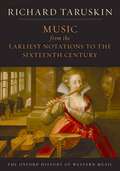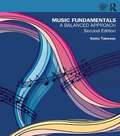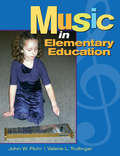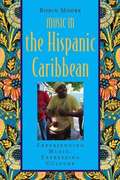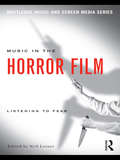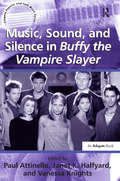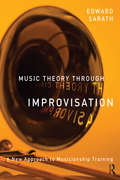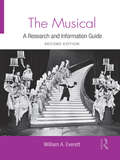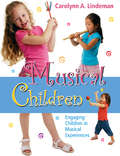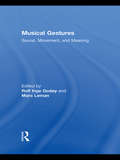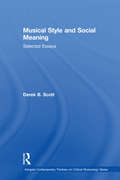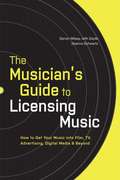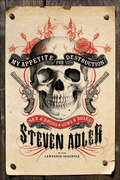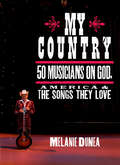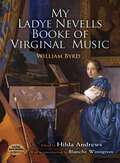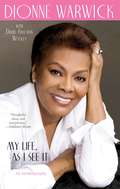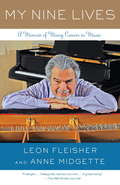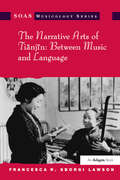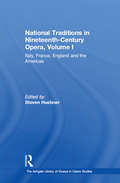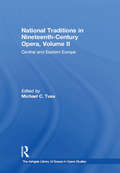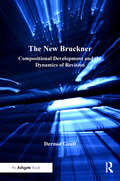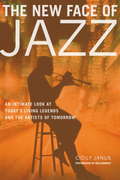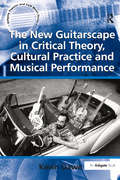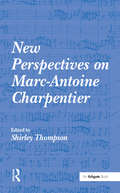- Table View
- List View
Music from the Earliest Notations to the Sixteenth Century: The Oxford History of Western Music
by Richard TaruskinThe universally acclaimed and award-winning Oxford History of Western Music is the eminent musicologist Richard Taruskin's provocative, erudite telling of the story of Western music from its earliest days to the present. Each book in this superlative five-volume set illuminates-through a representative sampling of masterworks- the themes, styles, and currents that give shape and direction to a significant period in the history of Western music. <p><p>This first volume in Richard Taruskin's majestic history, Music from the Earliest Notations to the Sixteenth Century , sweeps across centuries of musical innovation to shed light on the early forces that shaped the development of the Western classical tradition. Beginning with the invention of musical notation more than a thousand years ago, Taruskin addresses topics such as the legend of Saint Gregory and Gregorian chant, Augustine's and Boethius's thoughts on music, the liturgical dramas of Hildegard of Bingen, the growth of the music printing business, the literary revolution and the English madrigal, the influence of the Reformation and the Counter-Reformation, and the operas of Monteverdi. Laced with brilliant observations, memorable musical analysis, and a panoramic sense of the interactions between history, culture, politics, art, literature, religion, and music, this book will be essential reading for anyone who wishes to understand this rich and diverse period.
Music Fundamentals
by Sumy TakesueMusic Fundamentals: A Balanced Approach, Second Edition comprises a textbook/workbook and interactive website designed for those who want to learn the basics of reading music. Intended for students with little or no prior knowledge of music theory, it offers a patient approach for reading, writing and even performing music. Musical examples range from Elvis Presley songs to Beethoven symphonies, from rhythmically challenging African songs and syncopated Brazilian choro melodies, to humorous Filipino ballads and Schubert lieder. The website includes graded quizzes and numerous skill training exercises. By reinforcing musical concepts with numerous written examples, offering a more balanced mixture of global, classical, and popular music, and encouraging practice through an online, interactive tutorial, Music Fundamentals: A Balanced Approach, Second Edition is a comprehensive textbook for building musical foundations. Second Edition Features: Modular structure allows instructors to reorganize chapters. A variety of exercises help the student transform knowledge into practice: Listen and sing exercises for ear training Keyboard drills to be played on a real keyboard or piano, or the keyboard insert provided in the inside cover Clapping and counting exercises to ingrain a cerebral understand, but also a visceral feeling for pulse and rhythm Workbook review exercises at the end of each module facilitate progress to the next module. "Cultural Notes" discuss musical genres or place musical examples in a broader social context to give an enriched approach to music learning. Online tutorials assist with ear training and general concepts, and streaming of audio examples help to connect the study of theory to real music-making. The website features student interactive tutorials, and an Instructor Manual supplements teaching with a wealth of classroom exercises.
Music in Elementary Education
by John Flohr Valerie TrollingerBased on the National Standards, this text is divided into three parts. Part one, Foundations, covers the rationale for a Music Education program in the elementary years; meaning and musical experience; and elements and kinds of music. Part two– Music Elements, Curriculum and Avenues to Music Learning–covers curriculum development; music for special needs students; avenues to music learning and historic and contemporary approaches. Part three–Musical Experiences– is grouped by avenues of music learning and grades. Thanks to years of thorough research, Music in Elementary Education promises is a standard text in the field.
Music in the Hispanic Caribbean: Experiencing Music, Expressing Culture (Global Music Series)
by Robin MooreThe Spanish-speaking islands of Cuba, Puerto Rico, and the Dominican Republic make up a relatively small region, but their musical and cultural traditions have had a dramatic, sweeping impact on the world. This brief volume provides the reader with an introduction to the music of Cuba, Puerto Rico, and the Dominican Republic, as well as to various common themes and tendencies that have informed music making in those countries. The text provides a vibrant introduction to diverse musical styles including salsa, merengue, reggaeton, plena, Latin jazz, and the bolero. A comparative approach of writing about the three countries together helps us to think of the Hispanic Caribbean as an interconnected whole. A compelling, comprehensive review, Music in the Hispanic Caribbean is ideal for introductory undergraduate courses in world music or ethnomusicology and for upper-level courses on Caribbean and Latin American music and/or culture.
Music in the Horror Film: Listening to Fear
by Neil LernerMusic in Horror Film is a collection of essays that examine the effects of music and its ability to provoke or intensify fear in this particular genre of film. Frightening images and ideas can be made even more intense when accompanied with frightening musical sounds, and music in horror film frequently makes its audience feel threatened and uncomfortable through its sudden stinger chords and other shock effects. The essays in this collection address the presence of music in horror films and their potency within them. With contributions from scholars across the disciplines of music and film studies, these essays delve into blockbusters like The Exorcist, The Shining, and The Sixth Sense together with lesser known but still important films like Carnival of Souls and The Last House on the Left. By leading us with the ear to hear these films in new ways, these essays allow us to see horror films with fresh eyes.
Music, Sound, and Silence in Buffy the Vampire Slayer (Ashgate Popular And Folk Music Ser.)
by JanetK. HalfyardThe intense and continuing popularity of the long-running television show Buffy the Vampire Slayer (1997-2003) has long been matched by the range and depth of the academic critical response. This volume, the first devoted to the show's imaginative and widely varied use of music, sound, and silence, helps to develop an increasingly important and inadequately covered area of research - the many roles of music in contemporary television. In addressing this significant gap, this book provides an exemplary overview of the functions of music and sound in the interpretation of a television show. This is done through analyses that focus on scoring and source music, the title theme, the music production process, the critically acclaimed musical episode (voted number 13 in Channel Four's One Hundred Greatest Musicals), the symbolic and dramatic use of silence, and the popular reception of the show by its international fan base. In keeping with contemporary trends in the study of popular musics, a variety of critical approaches are taken from musicology, cultural studies, and media and communication studies, specifically employing critique, musical analysis, industry studies, and hermeneutics.
Music Theory Through Improvisation: A New Approach to Musicianship Training
by Ed SarathDesigned for Music Theory courses, Music Theory Through Improvisation presents a unique approach to basic theory and musicianship training that examines the study of traditional theory through the art of improvisation. The book follows the same general progression of diatonic to non-diatonic harmony in conventional approaches, but integrates improvisation, composition, keyboard harmony, analysis, and rhythm. Conventional approaches to basic musicianship have largely been oriented toward study of common practice harmony from the Euroclassical tradition, with a heavy emphasis in four-part chorale writing. The author’s entirely new pathway places the study of harmony within improvisation and composition in stylistically diverse format, with jazz and popular music serving as important stylistic sources. Supplemental materials include a play-along audio in the downloadable resources for improvisation and a companion website with resources for students and instructors.
The Musical: A Research and Information Guide (Routledge Music Bibliographies #94)
by William EverettThe musical, whether on stage or screen, is undoubtedly one of the most recognizable musical genres, yet one of the most perplexing. What are its defining features? How does it negotiate multiple socio-cultural-economic spaces? Is it a popular tradition? Is it a commercial enterprise? Is it a sophisticated cultural product and signifier? This research guide includes more than 1,400 annotated entries related to the genre as it appears on stage and screen. It includes reference works, monographs, articles, anthologies, and websites related to the musical. Separate sections are devoted to sub-genres (such as operetta and megamusical), non-English language musical genres in the U.S., traditions outside the U.S., individual shows, creators, performers, and performance. The second edition reflects the notable increase in musical theater scholarship since 2000. In addition to printed materials, it includes multimedia and electronic resources.
Musical Children, CD: Engaging Children in Musical Experiences
by Carolynn LindemanMusical Children: Engaging Children in Musical Experiences by Carolyn Lindeman is the only text that focuses on the teaching of preschool and kindergarten students and the important role music plays in a their educations and lives. Music educators are increasingly recognizing the importance of teaching musical skills as early as the preschool years. This book presents the latest research emphasizing real life applications so that teachers can achieve their goal of creating more musically creative children. The book presents 25 strategies for engaging children who are learning music based on the latest Music Educators National Conference (MENC) standards. It includes reproducible student activity charts, a song selection of 40 notated melodies, a collection of chants, and resource materials for any new teacher to reference. Musical Children is not only an excellent text in any Music Education classroom, but an excellent resource for any preschool or kindergarten teacher. Written by a leading authority on early childhood music education, the text will be used in courses on Elementary Methods and Fundamentals of Music Education. Audio-CD not for sale. Available for instructors upon request from Sales office
Musical Gestures: Sound, Movement, and Meaning
by Rolf Inge Godøy Marc LemanWe experience and understand the world, including music, through body movement–when we hear something, we are able to make sense of it by relating it to our body movements, or form an image in our minds of body movements. Musical Gestures is a collection of essays that explore the relationship between sound and movement. It takes an interdisciplinary approach to the fundamental issues of this subject, drawing on ideas, theories and methods from disciplines such as musicology, music perception, human movement science, cognitive psychology, and computer science.
Musical Style and Social Meaning: Selected Essays (Ashgate Contemporary Thinkers On Critical Musicology Ser.)
by DerekB. ScottWhy do we feel justified in using adjectives such as romantic, erotic, heroic, melancholic, and a hundred others when speaking about music? How do we locate these meanings within particular musical styles? These are questions that have occupied Derek Scott's thoughts and driven his critical musicological research for many years. In this selection of essays, dating from 1995-2010, he returns time and again to examining how conventions of representation arise and how they become established. Among the themes of the collection are social class, ideology, national identity, imperialism, Orientalism, race, the sacred and profane, modernity and postmodernity, and the vexed relationship of art and entertainment. A wide variety of musical styles is discussed, ranging from jazz and popular song to the symphonic repertoire and opera.
The Musician's Guide To Licensing Music: How To Get Your Music Into Film, Tv, Advertising, Digital Media And Beyond
by Darren Wilsey Daylle Deanna SchwartzRecord deals are so twentieth century. Today, music licensing is the fastest route to widespread exposure and a steady income. Creators of films, television shows, commercials, video games, ringtones, podcasts and other digital-age media hunger for music perfectly suited to their projects—providing endless, lucrative opportunities for savvy musicians. Whether you’re an unknown composer, an up-and-coming songwriter, an independent-label performer, or a big label star, there’s a place for you in this fast-growing field—as long as you learn to master the game.
Mustaine: A Heavy Metal Memoir
by Dave Mustaine Joe LaydenNew York Times BestsellerFounding member, singer, and lead guitarist of Metallica and Megadeath shares the ultimate, unvarnished story behind his involvement in the rise of two of the world’s most influential heavy metal bands in history. Dave Mustaine is the first to admit that he’s bottomed out a few times in his dark and twisted speed metal version of a Dickensian life. From his soul-crushing professional and artistic setbacks to his battle with addiction, Mustaine has hit rock bottom on multiple occasions. April 1983 was his lowest point, when he was unceremoniously fired from Metallica for his hard-partying ways. But, what seemed to be the end of it all was just the beginning for the guitarist. After parting ways with Metallica, Mustaine went on to become the front man, singer, songwriter, guitarist (and de facto CEO) for Megadeath—one of the most successful metal bands in the world. A pioneer of the thrash metal movement, Megadeath rose to international fame in the 1980s, and has gone on to earn seven consecutive Grammy nominations for Best Metal Performance. In this outrageously candid memoir, one of heavy metal’s most iconic figures gives an insider’s look into the loud and sordid world of thrash metal—sex, drugs, and rock n’ roll included.
My Appetite for Destruction: Sex & Drugs & Guns N' Roses
by Steven Adler Lawrence J. SpagnolaFrom Steven Adler, the original drummer for Guns N’ Roses, comes My Appetite for Destruction, the inside story of GNR. Offering a different perspective from the bestselling Slash, Adler chronicles his life with the band, and own intense struggle with addiction, as seen on Dr. Drew’s Celebrity Rehab and Sober House.
My Country: 50 Musicians on God, America & the Songs They Love
by Melanie DuneaNow in paperback, a volume of stunning photographs of 50 country music icons and intimate accounts of their thoughts on God, America, and their favorite songs.Award-winning photographer and author of My Last Supper, Melanie Dunea traces the throughlines from country music's gritty roots to the chart-topping chanteuses of today, presenting beautiful, imaginative, and revealing photographs of icons ranging from Taylor Swift to Wynnona Judd to Little Jimmy Dickens and conducting interviews that ask stars to discuss their musical roots and inspirations, their defining moments, and what makes country music the heart and soul of America.As the music industry fractures and suffers from flagging sales, country music has enjoyed explosive growth and unprecedented popularity. This totally unique book will be a must-own (and a perfect gift) for fans of the old time country twang and the millions who love the glitz and glamour of today's country-pop. My Country is a music-lovers dream, and in this more inexpensive, accessible market the book is sure to find its core audience amongst country music's legions of fans.
My Ladye Nevells Booke of Virginal Music (Dover Music for Piano)
by William ByrdA smaller version of the harpsichord, the virginal enjoyed wide popularity during the 16th and 17th centuries. Based upon a 1591 manuscript of keyboard works, this collection features 42 pieces in modern notation -- a vast amount of neglected concert material for modern pianists and harpsichordists -- plus historic and analytic notes.
My Life, as I See It
by David F Wooley Dionne WarwickDionne Warwick made her singing debut in church at the request of her grandfather, the Reverend Elzae Warrick, when she was six years old. No one knew then that she would become an international music legend, but what she knew--as words of wisdom passed down from her grandfather--was that "if you can think it, you can do it." And she did it. Dionne released the first of more than fifty-six charted hits in 1962 with "Don't Make Me Over," followed by "Anyone Who Had a Heart," "Walk On By," "I Say a Little Prayer," "Alfie," and "A House Is Not a Home," to name a few. She received her first Grammy in 1968 for "Do You Know the Way to San Jose" and later recorded the classic hit "That's What Friends Are For." She was considered the voice of Burt Bacharach/Hal David compositions, and the rest is here, in her first autobiography. Dionne tells the stories of her life from her childhood in East Orange, New Jersey, in a two-family home with her parents, brother, and sister, to now, as she celebrates her fiftieth year in show business. She came by her musical gifts honestly. Her mother, Lee Drinkard Warrick, was a founding member of the legendary Drinkard Jubilairs, which included her mother's siblings Cissy, Marie, Annie, Nick, and Larry. Cissy went on to become a celebrated recording artist in her own right; she lived in the Warrick household, got married, and later gave birth to one of the most popular singers of our time, Whitney Houston. Dionne went on to start her own gospel group with her sister, Dee Dee, called the Gospelaires. Her father, once a Pullman porter, became an accountant, went on to promote gospel records for Hob Records, and wrote a book on gospel music. She attributes her strong family, who are faithful and industrious Christians, for keeping her grounded and giving her the fortitude, as well as the talent, to earn her place among world-class performing artists without losing herself or her soul.
My Nine Lives: A Memoir of Many Careers in Music
by Leon Fleisher Anne MidgetteWith his coauthor, celebrated music critic Midgette, pianist Fleisher explores the depression that engulfed him as his condition worsened and, perhaps most powerfully of all, the sheer love of music that rescued him from complete self-destruction.
The Narrative Arts of Tianjin: Between Music and Language (SOAS Studies in Music Series)
by Francesca R. LawsonIn studying one of the world's oldest and most enduring musical cultures, academics have consistently missed one of the richest forms of Chinese cultural expression: performed narratives. Francesca R. Sborgi Lawson explores the relationships between language and music in the performance of four narrative genres in the city of Tianjin, China, based upon original field research conducted in the People's Republic of China in the mid 1980s and in 1991. The author emphasizes the unique nature of oral performances in China: these genres are both musical and literary and yet are considered to be neither music nor literature. Lawson employs extensive examples of the complex interaction of music and language in each genre, all the while relating those analyses to broader cultural issues and to patterns of social relationships. The narrative arts known as shuochang (speaking-singing) are depicted as genres that constitute a unique communicative discourse”the communication of stories in song. The genres subsumed under the native conception of shuochang include Tianjin Popular Tunes, Beijing Drumsong, Clappertales and Comic Routines. The maximum utilization of shuo (speaking) and chang (singing) in all their varying manifestations constitutes the vitality of the traditional narrative arts in the city of Tianjin”the center for these arts in North China. The variety of narrative forms provides entertainment for audiences representing all social strata of Chinese society. The author argues that Chinese narrative traditions represent a foundation from which certain Chinese literary and operatic traditions have borrowed, such as how the novels from the Ming-Qing period draw on the performed narrative arts both in style and in content. Hence, an understanding of performed narratives is not only useful to scholars in Chinese literature and music, but also to scholars interested in broadening their understanding of China generally.
National Traditions in Nineteenth-Century Opera, Volume I: Italy, France, England and the Americas (The Ashgate Library of Essays in Opera Studies #4)
by Steven HuebnerThis volume covers opera in Italy, France, England and the Americas during the long nineteenth century (1789-1914). The book is divided into four sections that are thematically, rather than geographically, conceived: Places-essays centering on contexts for operatic culture; Genres and Styles-studies dealing with the question of how operas in this period were put together; Critical Studies of individual works, exemplifying particular critical trends; and Performance.
National Traditions in Nineteenth-Century Opera, Volume II: Central and Eastern Europe (The Ashgate Library of Essays in Opera Studies)
by Michael C. TusaThis volume offers a cross-section of English-language scholarship on German and Slavonic operatic repertories of the "long nineteenth century," giving particular emphasis to four areas: German opera in the first half of the nineteenth century; the works of Richard Wagner after 1848; Russian opera between Glinka and Rimsky-Korsakov; and the operas of Richard Strauss and Janácek. The essays reflect diverse methods, ranging from stylistic, philological, and historical approaches to those rooted in hermeneutics, critical theory, and post-modernist inquiry.
The New Bruckner: Compositional Development and the Dynamics of Revision
by Dermot GaultThe New Bruckner provides a valuable study of Bruckner's music, focusing on the interaction of biography, textual scholarship, reception history and analysis. Dr Dermot Gault conveys a broad chronological narrative of Bruckner's compositional development, interpolating analytical commentaries on the works and critical accounts of the notoriously complex and editorial issues. Gault corrects longstanding misconceptions about the composer's revision process, and its relationship with the early editions and widely-held critical opinions. Bruckner's constantly evolving engagement with symphonic form is traced by taking each revision in due order, rather than by taking each symphony on its own, and by relating the symphonies to other mature works such as the Te Deum, the three great Masses, and the Quintet, and argues that Bruckner's music became more organic and less schematic as the result of his revisions. The book will be essential reading for those studying Bruckner's compositions, the complex history of their reception, and late Romantic music in general.
The New Face of Jazz: An Intimate Look at Today's Living Legends and the Artists of Tomorrow
by Cicily JanusJazz is thriving in the twenty-first century, andThe New Face of Jazzis an intimate, illustrated guide to the artists, venues, and festivals of today's jazz scene. This book celebrates the living legends, current stars, and faces of tomorrow as they continue to innovate and expand the boundaries of this great musical legacy. In their own words, artists such as McCoy Tyner, Arturo Sandoval, Diane Schuur, Terence Blanchard, Charlie Hunter, Nicholas Payton, George Benson, Maria Schneider, Christian McBride, Randy Brecker, Jean-Luc Ponty, Joe Lovano, Lee Ritenour, and more than 100 others share intimately about their beginnings, musical training, inspiration, and hard-earned lessons, creating a fascinating mosaic of the current jazz community. Photographer Ned Radinsky contributes 40 amazing black-and-white portraits of these musicians doing what they do best-playing. An appendix offers resources for jazz education; an exclusive reading list; and the lowdown on those organizations and societies doing their part to promote jazz as a living, breathing art form. With an introductory word from Wynton Marsalis, a foreword by Marcus Miller, and an afterword by Sonny Rollins,The New Face of Jazzis an unprecedented window onto today's world of jazz, for everyone from the devotee to the new listener.
The New Guitarscape in Critical Theory, Cultural Practice and Musical Performance (Ashgate Popular And Folk Music Ser.)
by Kevin DaweIn The New Guitarscape, Kevin Dawe argues for a re-assessment of guitar studies in the light of more recent musical, social, cultural and technological developments that have taken place around the instrument. The author considers that a detailed study of the guitar in both contemporary and cross-cultural perspectives is now absolutely essential and that such a study must also include discussion of a wide range of theoretical issues, literature, musical cultures and technologies as they come to bear upon the instrument. Dawe presents a synthesis of previous work on the guitar, but also expands the terms by which the guitar might be studied. Moreover, in order to understand the properties and potential of the guitar as an agent of music, culture and society, the author draws from studies in science and technology, design theory, material culture, cognition, sensual culture, gender and sexuality, power and agency, ethnography (real and virtual) and globalization. Dawe presents the guitar as an instrument of scientific investigation and part of the technology of globalization, created and disseminated through corporate culture and cottage industry, held close to the body but taken away from the body in cyberspace, and involved in an enormous variety of cultural interactions and political exchanges in many different contexts around the world. In an effort to understand the significance and meaning of the guitar in the lives of those who may be seen to be closest to it, as well as providing a critically-informed discussion of various approaches to guitar performance, technologies and techniques, the book includes discussion of the work of a wide range of guitarists, including Robert Fripp, Kamala Shankar, Newton Faulkner, Lionel Loueke, Sharon Isbin, Steve Vai, Bob Brozman, Kaki King, Fred Frith, John 5, Jennifer Batten, Guthrie Govan, Dominic Frasca, I Wayan Balawan, Vicki Genfan and Hasan Cihatter.
New Perspectives on Marc-Antoine Charpentier
by Shirley ThompsonThe tercentenary of Marc-Antoine Charpentier's death in 2004 stimulated a surge of activity on the part of performers and scholars, confirming the modern assessment of Charpentier (1643-1704) as one of the most important and inventive composers of the French Baroque. The present book provides a snapshot of Charpentier scholarship in the early years of the new century. Its 13 chapters illustrate not only the sheer variety of strands currently pursued, but also the way in which these strands frequently intertwine and generate the potential for future research. Between them, they examine facets of the composer's compositional language and process, aspects of his performance practice and notation, the contexts within which he worked, and the nature of his legacy. The appendix contains a transcription of the inventory of Charpentier's manuscripts prepared when their sale to the Royal Library was negotiated in 1726 - an invaluable research tool, as numerous chapters in the book demonstrate. The wide variety of topics covered here will appeal both to readers interested in Charpentier's music and to those with a broader interest in the music and culture of the French Baroque, including aspects of patronage, church and theatre. Far from treating his output in isolation, this book places it in the wider context alongside such composers as Lully, Lalande, Marais, Fran‘s Couperin and Rameau; it also views the composer in relation to his Italian training. In the process, the under-examined question of influence - who influenced Charpentier? whom did he influence? - repeatedly comes to the fore. The book's Foreword was written by H. Wiley Hitchcock shortly before he died. Hitchcock's own part in raising the profile of Charpentier and his music to the level of recognition which it now enjoys cannot be emphasized enough. Appropriately the volume is dedicated to his memory.
